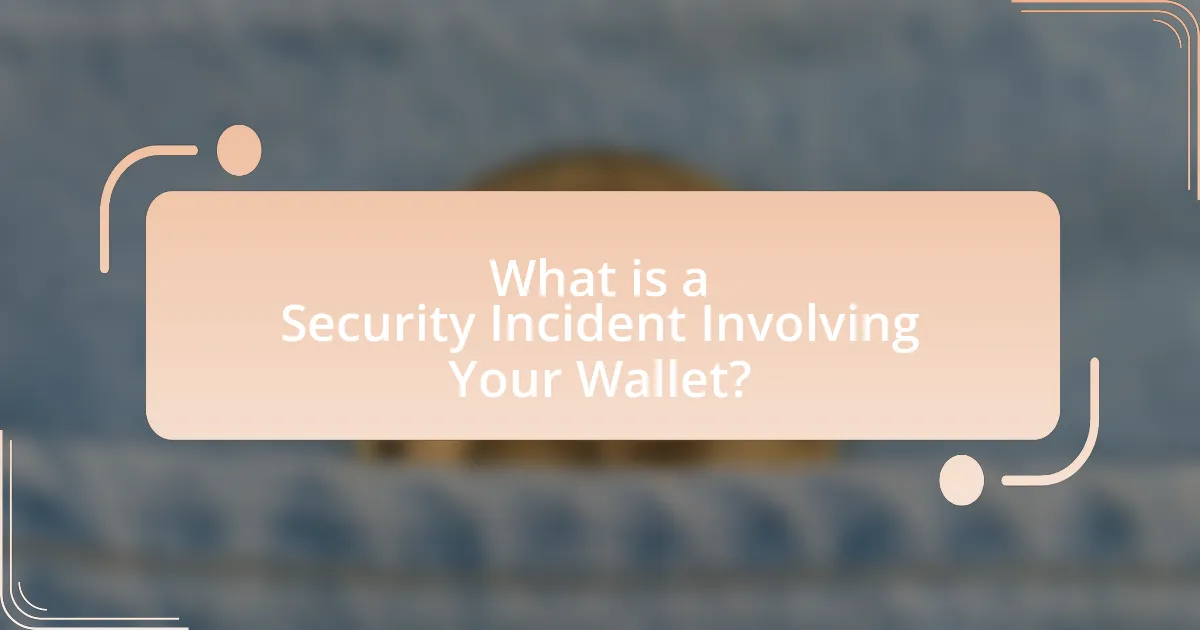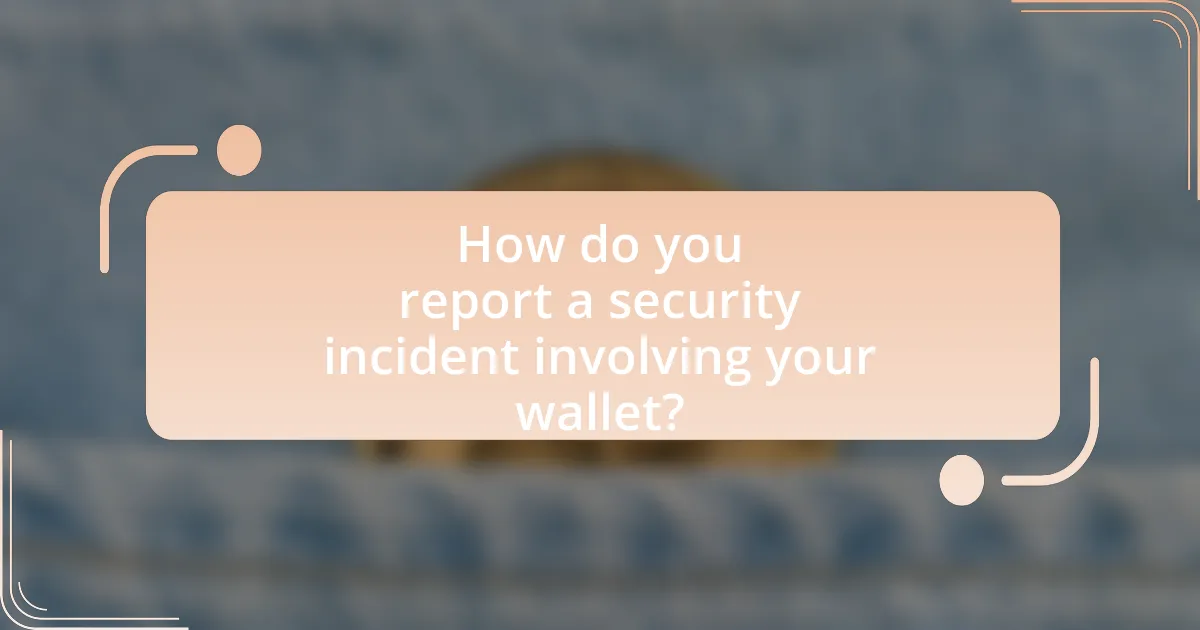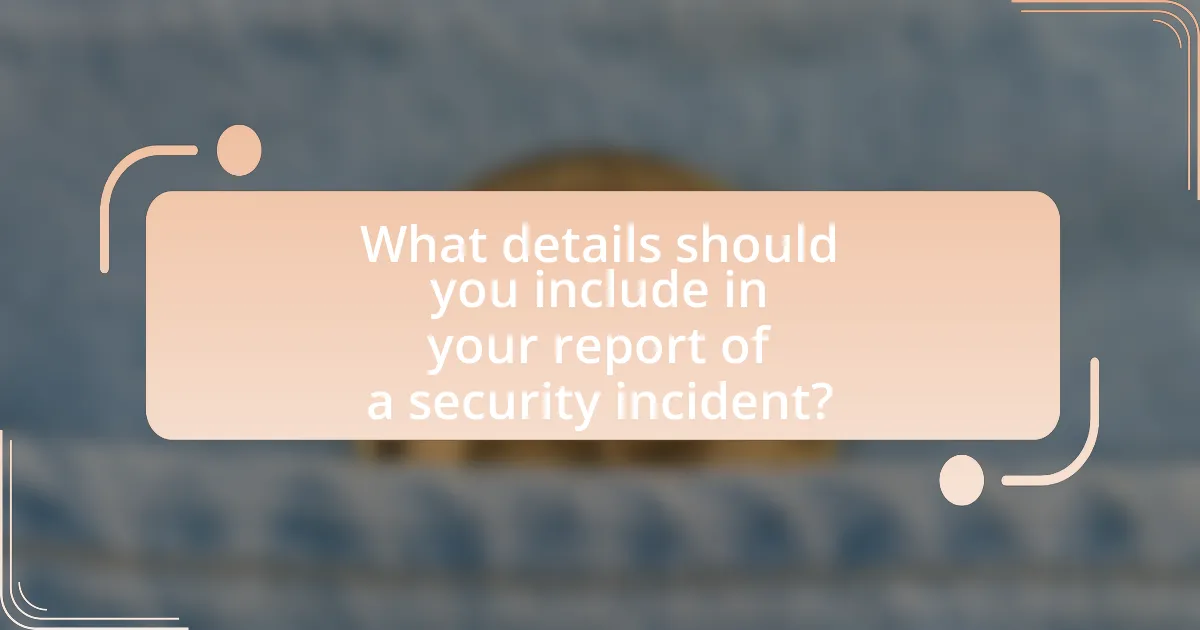A security incident involving your wallet refers to unauthorized access, theft, or compromise of digital wallets that store cryptocurrencies or sensitive financial information. Identifying such incidents involves monitoring for unauthorized transactions and unusual account activity. The article outlines the importance of reporting these incidents to mitigate financial losses and protect personal information, detailing the steps to take immediately after discovering a breach, how to secure your wallet, and the necessary information to include in a report. Additionally, it emphasizes best practices for preventing future security incidents and the tools available to enhance wallet security.

What is a Security Incident Involving Your Wallet?
A security incident involving your wallet refers to any unauthorized access, theft, or compromise of your digital wallet, which stores cryptocurrencies or sensitive financial information. Such incidents can occur through hacking, phishing attacks, or malware, leading to the loss of funds or personal data. For instance, in 2021, the cryptocurrency exchange Poly Network experienced a security breach where hackers stole over $600 million, highlighting the vulnerabilities associated with digital wallets.
How can you identify a security incident related to your wallet?
You can identify a security incident related to your wallet by monitoring for unauthorized transactions, unusual account activity, or alerts from your wallet provider. Unauthorized transactions indicate that someone may have accessed your wallet without permission, while unusual account activity, such as changes to your account settings or login attempts from unfamiliar devices, can signal a breach. Additionally, wallet providers often send alerts for suspicious activities, which can serve as an early warning of potential security incidents.
What signs indicate that your wallet has been compromised?
Signs that indicate your wallet has been compromised include unauthorized transactions, unexpected changes in account settings, and notifications of login attempts from unfamiliar devices. Unauthorized transactions can manifest as charges you did not make, which may appear in your transaction history. Unexpected changes in account settings, such as altered passwords or recovery information, suggest that someone else has accessed your account. Notifications of login attempts from unfamiliar devices indicate potential unauthorized access. These signs are critical to identify early to mitigate further risks.
How can you differentiate between a minor issue and a serious security incident?
To differentiate between a minor issue and a serious security incident, assess the impact and scope of the event. A minor issue typically involves isolated incidents with limited consequences, such as a temporary inability to access a wallet, while a serious security incident involves significant threats, such as unauthorized access to sensitive information or substantial financial loss. For example, the 2014 Mt. Gox hack, which resulted in the loss of 850,000 Bitcoins, exemplifies a serious security incident due to its extensive impact on users and the cryptocurrency market. In contrast, a minor issue might involve a user forgetting their password, which can be resolved through standard recovery procedures without broader implications.
Why is it important to report a security incident involving your wallet?
Reporting a security incident involving your wallet is crucial to mitigate potential financial losses and protect personal information. When incidents are reported, it enables authorities and service providers to investigate the breach, identify vulnerabilities, and implement measures to prevent future occurrences. For instance, according to the Cybersecurity & Infrastructure Security Agency (CISA), timely reporting of security incidents can lead to faster recovery and reduced impact on victims. Additionally, reporting helps in tracking criminal activities, which can aid in apprehending cybercriminals and enhancing overall security for all users.
What are the potential consequences of not reporting a security incident?
Not reporting a security incident can lead to severe consequences, including financial loss, data breaches, and legal repercussions. Organizations may face significant financial losses due to fraud or theft, as unreported incidents can escalate and result in larger breaches. Additionally, failure to report can compromise sensitive data, leading to identity theft or unauthorized access to personal information. Legal consequences may arise from non-compliance with regulations that mandate incident reporting, resulting in fines or penalties. According to the Ponemon Institute’s 2021 Cost of a Data Breach Report, the average cost of a data breach is $4.24 million, underscoring the financial impact of not addressing security incidents promptly.
How does reporting help in preventing future incidents?
Reporting helps in preventing future incidents by identifying patterns and vulnerabilities that can be addressed. When incidents are reported, organizations can analyze the data to understand the root causes and implement corrective measures. For instance, a study by the Ponemon Institute found that organizations that actively report and analyze security incidents can reduce the likelihood of future breaches by up to 30%. This proactive approach not only enhances security protocols but also fosters a culture of awareness and vigilance among users, ultimately leading to a more secure environment.

How do you report a security incident involving your wallet?
To report a security incident involving your wallet, immediately contact the wallet provider’s customer support or security team through their official channels. This action is crucial as it allows the provider to take necessary measures to secure your account and investigate the incident. Additionally, document all relevant details of the incident, such as transaction IDs, timestamps, and any suspicious activity observed. Reporting promptly can help mitigate potential losses and assist in recovering compromised assets.
What steps should you take immediately after discovering a security incident?
Immediately after discovering a security incident, you should contain the incident by isolating affected systems to prevent further damage. This step is crucial as it limits the potential spread of the breach and protects sensitive information. Following containment, you must assess the extent of the incident by gathering relevant data, such as logs and user reports, to understand what occurred. Documentation of the incident is essential for future analysis and reporting. After assessment, notify your internal security team or relevant authorities to initiate a formal investigation. This process is supported by the fact that timely reporting can significantly reduce the impact of security breaches, as highlighted in studies by cybersecurity experts.
How can you secure your wallet before reporting the incident?
To secure your wallet before reporting the incident, immediately change your wallet’s password and enable two-factor authentication if available. This action prevents unauthorized access to your wallet and protects your assets. Additionally, review recent transactions for any unauthorized activity and report them to your wallet provider. According to cybersecurity experts, taking these steps can significantly reduce the risk of further loss and enhance the security of your digital assets.
What information should you gather before making a report?
Before making a report on a security incident involving your wallet, gather specific information including the date and time of the incident, the type of wallet (hardware, software, or paper), and details of the transaction or activity that raised concern. Additionally, collect any relevant transaction IDs, screenshots, or error messages that occurred during the incident. This information is crucial as it provides a clear timeline and context for the report, enabling investigators to understand the situation better and take appropriate action. Accurate documentation of these details can significantly enhance the effectiveness of the report and facilitate a quicker resolution.
Where can you report a security incident involving your wallet?
You can report a security incident involving your wallet to the customer support of the wallet provider or platform you are using. Most reputable wallet services have dedicated channels for reporting security issues, such as a support email, a contact form on their website, or a customer service hotline. Additionally, if the incident involves theft or fraud, it is advisable to report it to local law enforcement and, if applicable, to your country’s cybercrime unit.
What are the official channels for reporting incidents to wallet providers?
The official channels for reporting incidents to wallet providers typically include customer support hotlines, dedicated email addresses for security issues, and in-app reporting features. Wallet providers like Coinbase, Binance, and others often have specific sections on their websites outlining the steps for reporting security incidents, which may include submitting a support ticket or using a live chat option. For example, Coinbase provides a support page where users can report unauthorized transactions or account access issues directly.
How can law enforcement assist in reporting a security incident?
Law enforcement can assist in reporting a security incident by providing guidance on the proper procedures for filing a report and collecting evidence. They can help victims understand the legal implications of the incident and ensure that the report is documented accurately, which is crucial for any potential investigation. Additionally, law enforcement agencies often have dedicated cybercrime units that specialize in handling security incidents related to digital wallets, offering expertise that can enhance the investigation process. This assistance is vital, as timely reporting can significantly increase the chances of recovering lost assets and preventing further criminal activity.

What details should you include in your report of a security incident?
In your report of a security incident, include the date and time of the incident, a detailed description of what occurred, the type of security breach, the systems or data affected, and any actions taken in response. Additionally, document the identities of individuals involved, including witnesses, and any relevant communications or evidence, such as screenshots or logs. This information is crucial for understanding the incident’s scope and for any subsequent investigations or legal actions.
How can you effectively communicate the nature of the incident?
To effectively communicate the nature of the incident, clearly describe the event, including what occurred, when it happened, and the specific impact on your wallet. Providing detailed information such as transaction IDs, timestamps, and any suspicious activity enhances clarity. For instance, if unauthorized transactions were made, specify the amounts and dates, as this data helps investigators understand the situation better. Accurate and concise reporting ensures that the relevant parties can respond appropriately and take necessary actions to mitigate further risks.
What specific information about the incident is crucial to include?
The specific information crucial to include about the incident involves the date and time of the occurrence, the nature of the security breach, the wallet address affected, and any transactions that were unauthorized. This information is essential for accurately assessing the incident’s impact and for any subsequent investigations. For instance, documenting the exact time can help trace the sequence of events, while identifying unauthorized transactions can assist in recovering lost funds or preventing further losses.
How can you describe the timeline of events accurately?
To describe the timeline of events accurately, document each event in chronological order, specifying the date and time of occurrence. This method ensures clarity and allows for a precise understanding of the sequence of actions taken during the security incident. For instance, if a wallet was compromised on March 1, 2023, at 10:00 AM, followed by unauthorized transactions at 10:15 AM, and a report was filed at 10:30 AM, listing these details in order provides a clear timeline. Accurate timelines are crucial for investigations and can aid in identifying patterns or causes of the incident.
What follow-up actions should you take after reporting the incident?
After reporting the incident, you should monitor your accounts for any unauthorized transactions. This action is crucial as it allows you to quickly identify and respond to any fraudulent activities that may arise following the incident. Additionally, you should change your passwords and enable two-factor authentication on your accounts to enhance security. These steps are supported by cybersecurity best practices, which emphasize the importance of proactive measures in safeguarding personal information after a security breach.
How can you monitor your wallet for further suspicious activity?
To monitor your wallet for further suspicious activity, regularly check transaction history and set up alerts for any unusual transactions. Monitoring tools, such as wallet tracking applications, can provide real-time notifications for transactions, helping to identify unauthorized access quickly. According to a report by the Blockchain Security Alliance, 70% of cryptocurrency thefts occur due to compromised wallets, emphasizing the importance of vigilance in monitoring wallet activity.
What steps can you take to recover lost funds, if applicable?
To recover lost funds, first contact your financial institution or wallet provider immediately to report the incident. They may have specific procedures in place to assist with fund recovery. Next, gather all relevant transaction details, including dates, amounts, and any communication related to the loss, as this information will support your claim. Additionally, consider filing a report with local law enforcement and relevant regulatory bodies, as this can provide further documentation of the incident. If the loss involves a cryptocurrency wallet, you may also explore blockchain tracing services that can help track the movement of funds. According to the Federal Trade Commission, prompt reporting increases the chances of recovering lost funds, as timely action can lead to quicker investigations.
What are some best practices for preventing future security incidents with your wallet?
To prevent future security incidents with your wallet, implement strong password practices, enable two-factor authentication, and regularly update your software. Strong passwords should be complex, combining letters, numbers, and symbols, making them difficult to guess. Two-factor authentication adds an extra layer of security by requiring a second form of verification, significantly reducing the risk of unauthorized access. Regular software updates ensure that any vulnerabilities are patched, as outdated software can be an easy target for attackers. According to a 2021 report by Cybersecurity Ventures, 60% of small businesses that suffer a cyber attack go out of business within six months, highlighting the importance of these security measures.
How can you enhance the security of your wallet?
To enhance the security of your wallet, utilize strong, unique passwords and enable two-factor authentication (2FA). Strong passwords reduce the risk of unauthorized access, while 2FA adds an additional layer of security by requiring a second form of verification, such as a text message or authentication app. According to a study by Google, enabling 2FA can block 100% of automated bots and 96% of bulk phishing attacks, significantly improving account security.
What tools and resources are available to help protect your wallet?
To protect your wallet, various tools and resources are available, including hardware wallets, software wallets with strong encryption, and security applications. Hardware wallets, such as Ledger and Trezor, store private keys offline, significantly reducing the risk of hacking. Software wallets, like Exodus and Electrum, offer features such as two-factor authentication and backup options to enhance security. Additionally, security applications, including antivirus software and VPNs, help safeguard devices from malware and unauthorized access. According to a report by the Cybersecurity & Infrastructure Security Agency, using these tools can mitigate risks associated with digital asset management.